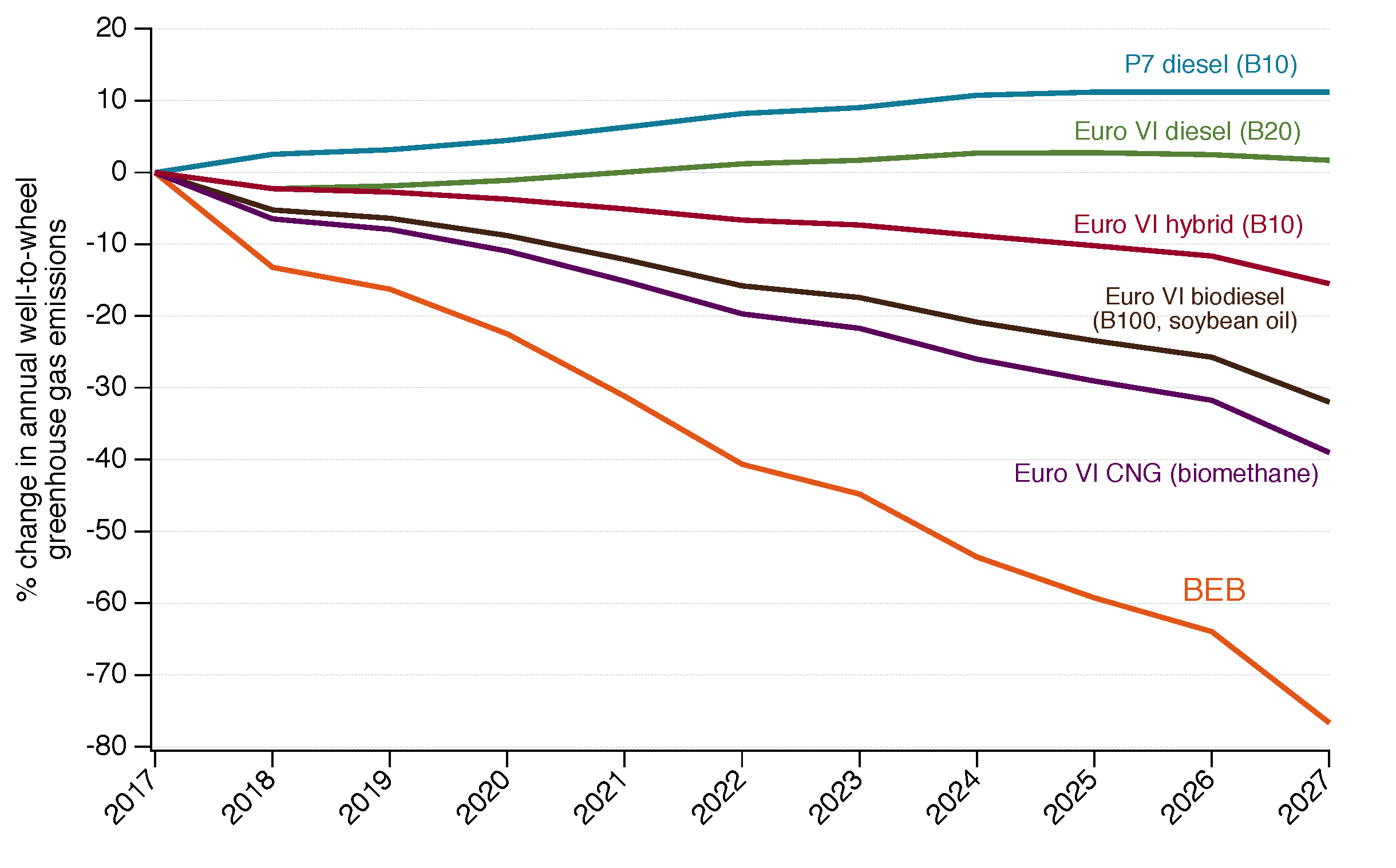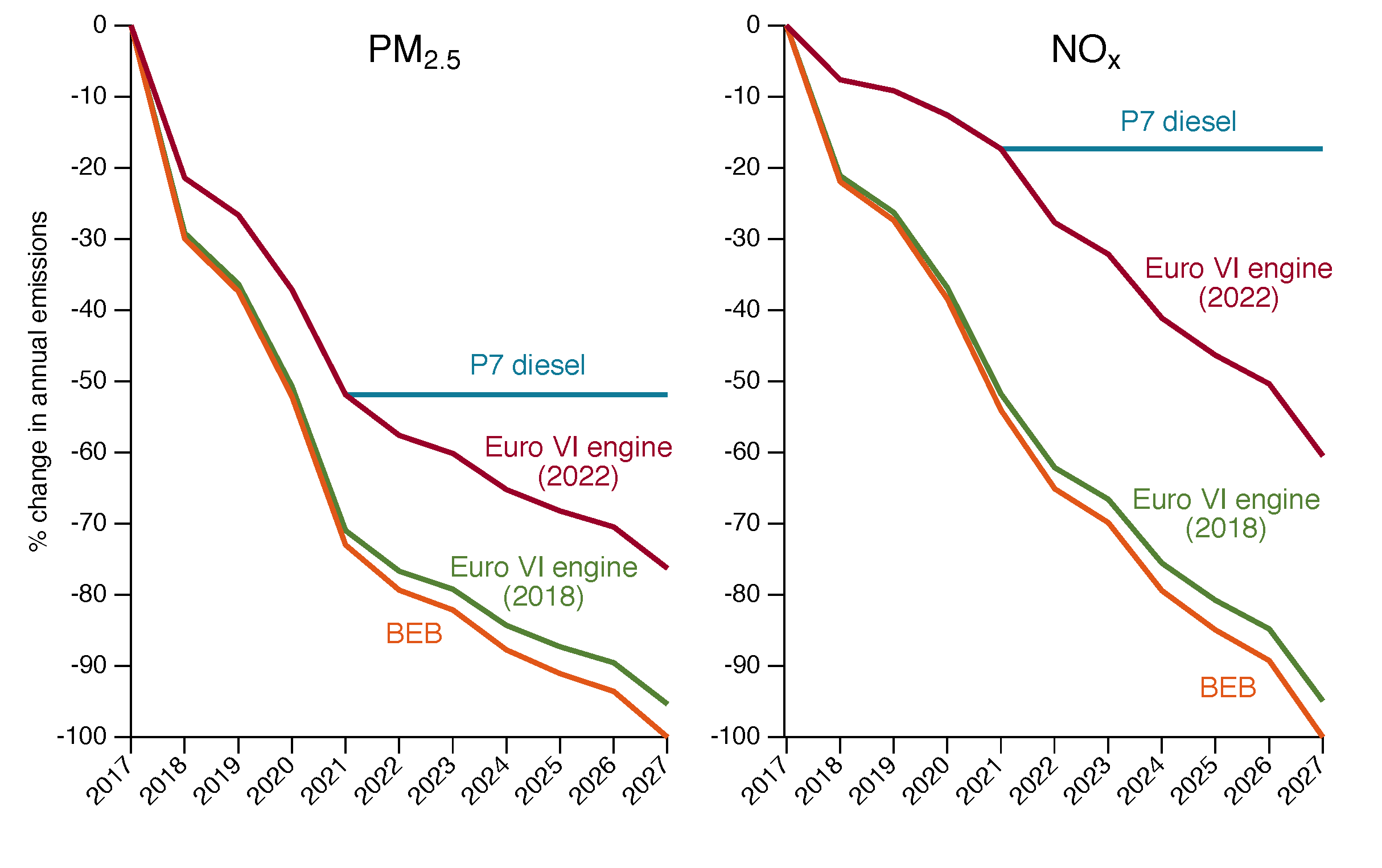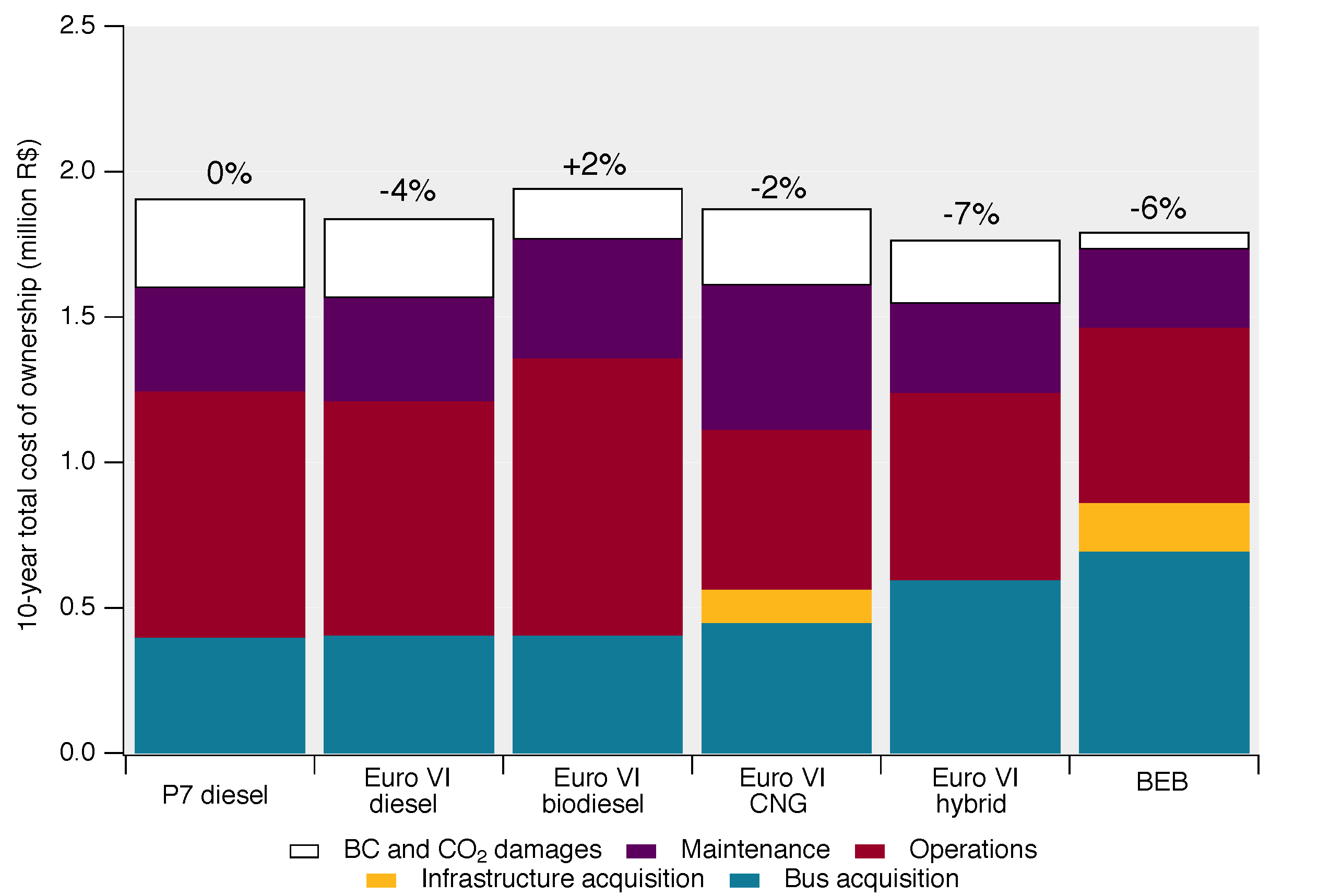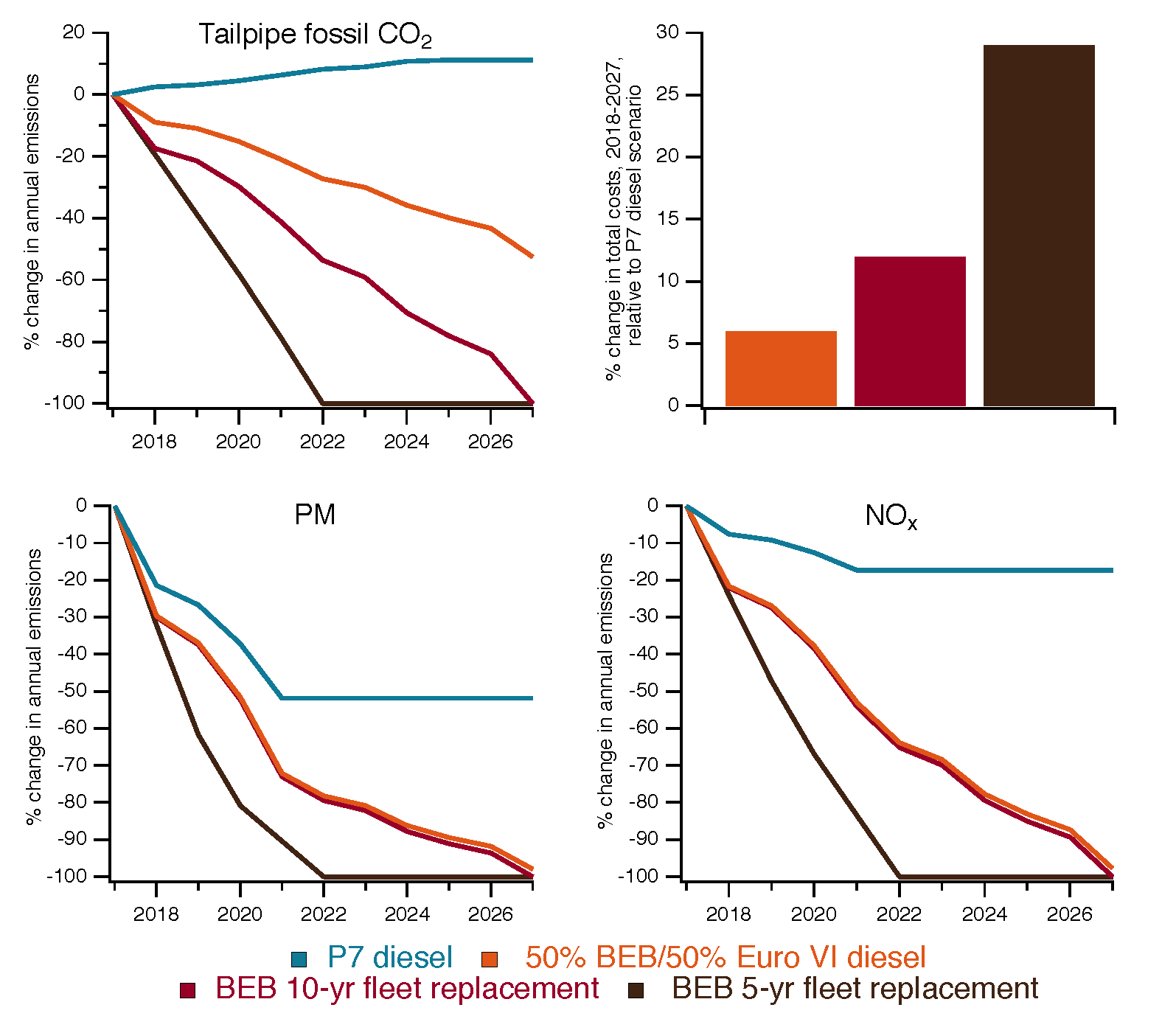Deficiencies in the Brazilian PROCONVE P-7 and the case for P-8 standards
Blog
Legislative do over creates opportunity for clean bus transition in São Paulo
On September 12, 2017, the Climate Committee of São Paulo approved a proposed amendment to Article 50 of the city’s Climate Change Law, one of several proposals now under discussion to improve the environmental performance of the city’s transit bus fleet. When passed in 2009, the Climate Change Law was a forward-looking effort to define municipal policy on climate change. Article 50 of the law addressed the municipal transit fleet and called for a 10% per year reduction in the number of city buses running on fossil fuels, with an ultimate target of a 100% non-fossil fuel fleet by 2018.
Unfortunately, the targets of Article 50 proved to be overly ambitious and the original goals of the program went almost entirely unrealized; today less than 2% of the city’s fleet of nearly 15,000 buses operate on non-fossil fuels. Given this lack of compliance, an amendment to Article 50 is needed to put the clean bus transition in São Paulo back on track.
The Climate Committee’s proposal is one of several that have been put forth by policymakers and other city stakeholders. These proposals have set the stage for negotiations on the best path forward for São Paulo’s bus fleet to reduce emissions of climate pollutants and toxic air pollutants such as particulate matter (PM) and nitrogen oxides (NOx).
Actions to set ambitious emissions reduction targets would place São Paulo amongst global leaders — Los Angeles, London, Shenzhen — who are all accelerating transitions to low or zero emission bus fleets. However, while setting targets is the easy part; getting clean buses on São Paulo’s roads has proven to be difficult in the past. As the amendment to Article 50 is being discussed, it is useful to take stock of where the environmental performance of the current fleet stands and what can be achieved with transitions to cleaner engine technologies and fuels.
Today, the São Paulo bus fleet is about equally split between diesel buses certified to P5 (Euro III equivalent) and P7 (Euro V equivalent) emission standards. If strong emission reduction targets are adopted, the city will have to quickly transition to cleaner engine technologies and fuels. Fortunately, there are many options available to do this: diesel and compressed natural gas (CNG) engines certified to Euro VI emission standards greatly reduce PM and NOx emissions relative to Euro V diesel engines; hybrid buses and biofuels can contribute to CO2 emissions targets. Battery electric buses (BEBs) have zero tailpipe emissions and, because of the large percentage of Brazilian electricity produced from hydropower, offer the potential for deep lifecycle CO2 emission reductions.
So, what’s the best path forward for São Paulo? There are many questions that need to be addressed when considering technology transitions such as this, of which perhaps the most fundamental relates to the ability of each of these technologies to contribute to CO2 and air pollutant emissions reduction goals.
To shed some light on this question, we looked at how emissions from the São Paulo bus fleet would change with transitions to alternative engine technologies and fuels. We modeled hypothetical scenarios in which the current bus fleet is completely replaced with buses of a given engine technology and fuel type over a 10-year period and compared against a baseline scenario where all new bus purchases are P7 diesels, Brazil’s current national standard. While these are somewhat unrealistic scenarios — a mix of technologies is the most likely pathway forward — they do provide a starting point for understanding which technologies make the most sense for São Paulo.
The figure below shows results for well-to-wheel (WTW) emissions of greenhouse gases (GHGs). The WTW framework considers both direct tailpipe GHG emissions and upstream emissions attributable to fuel and feedstock production and transport. This differs somewhat from the CO2 accounting method being discussed for amendments to Article 50, which consider tailpipe emissions only. However, we think the WTW framework more accurately reflects the true climate benefits (or disadvantages) of alternative engine technologies and fuels. It is particularly important to consider upstream effects from biofuels, some of which can result in comparable or even higher emissions than fossil fuels.

It is clear that, under the WTW framework, BEBs offer the greatest potential for reducing the climate impacts of the São Paulo bus fleet. This is because electric drivetrains are more efficient than internal combustion engines and the Brazilian electricity grid has a very low carbon intensity. WTW GHG emissions would be reduced by about 75% if the current bus fleet were replaced with BEBs. Transitions to biodiesel (B100), biomethane or hybrid buses offer comparatively smaller GHG benefits, on the order of 20–40% below today’s levels.
It is important to highlight the relative difference in WTW GHG emissions from BEBs and biodiesel buses. Under the accounting system being discussed for the amendment to Article 50, both of these bus types would be considered to have zero tailpipe emissions of fossil-derived CO2. However, considering the fuel lifecycle emissions of these technologies reveals the actual climate impacts of the two bus types are clearly quite different. The key message here is that BEBs offer the best opportunity for long-term climate benefits from São Paulo’s fleet.
What about air pollutants? Well, here the story is relatively straightforward: to greatly reduce emissions of toxic air pollutants, São Paulo should transition to Euro VI certified buses or BEBs as soon as possible. The figure below shows that, assuming normal fleet turnover, PM and NOx emissions would be reduced by >90% if all new buses purchased beginning in 2018 meet Euro VI emission standards. BEBs are even better, but not strictly needed for deep air pollution emission reductions if all engines meet Euro VI standards. Accelerated action to reduce PM emissions from the São Paulo fleet will also reduce emissions of black carbon (BC), a key component of PM emitted from diesel engines and a potent short-lived climate pollutant.

The good news is that São Paulo need not wait for national implementation of Euro VI equivalent emission standardscommitted to making soot-free engine technologies, such as Euro VI diesel or cleaner engines,* available in São Paulo beginning in 2018.
Clean engine technologies and fuels not only make sense for the air quality of São Paulo and the global climate, they also make economic sense. Although the purchase price of these technologies can be higher than a P7 diesel bus, reduced operational and maintenance costs can lead to net savings over the lifetime of the vehicle. The figure below illustrates our estimates of how the total cost of ownership varies by engine technology for a padron type bus. In the case where only direct costs are considered, Euro VI diesel and hybrid buses have lower lifetime costs than P7 diesel buses, while the cost of a biodiesel bus or a BEB is slightly higher. When the societal costs of the health and climate damages of BC and CO2 emissions are accounted for, though, Euro VI hybrids and BEBs are the clear winners.

What about a faster transition to BEBs? Our analysis shows tailpipe fossil CO2, PM, and NO¬x emissions could be reduced by 50%, 98%, and 98%, respectively, in 10 years if new bus purchases are split equally between BEBs and Euro VI diesel buses. More ambitious procurement strategies, such as a full transition to BEBs over a 5 or 10-year period, have been suggested as alternative pathways for São Paulo’s transition to a clean bus fleet. These pathways would accelerate emission reductions, however, as is shown in the figure below, these reductions would come at a cost. This is especially true for a hypothetical 5-year transition to a 100% BEB fleet, where total expenditures over the period 2018–2022 would be about R$ 7 billion greater than in the scenario where a mix of Euro VI diesel buses and BEBs are incorporated into the fleet over a 10-year period. Such a fast and complete transition to a new technology, in this case BEBs, should also be approached with caution for reasons of operational viability.

São Paulo’s clean bus transition has been delayed for long enough. The negotiations of the Article 50 amendment provide an opportunity for policymakers to put the city back on the right path for fulfilling climate, health, and technology innovation goals. Strong actions would place the city ahead of the curve as more and more cities around the world consider similar transitions to clean bus fleets.
* Revised 11/27/2017 to clarify that the commitment made by several bus and engine manufacturers through the Global Industry Partnership on Soot-Free Clean Bus Fleets is to making soot-free engine technologies available to São Paulo no later than 2018. Soot-free engine technologies include any diesel or alternative fuel engine that meets Euro VI or US 2010 emissions; and any diesel engine with a diesel particulate filter, gas engine, or dedicated electric drive engine.
